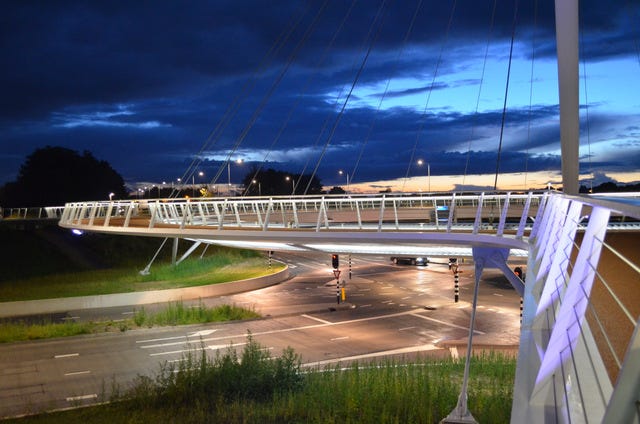Bring on the Spin Bus!

In my previous article (Self-driving cars will kill the urban renaissance, and we’ll be happy about it), I argued that autonomous vehicles will reverse the recent trend towards migration from suburbs to cities, with unknown consequences for the urban renaissance. In this article, I highlight some of the interesting things you should expect to see from the autonomous vehicle revolution.
I’ve broadly divided these up into two phases: i) after the introduction of autonomous cars but before their ubiquity and ii) after the government mandates that all cars are autonomous (and manual driving is mostly outlawed).
Phase i- the autonomous cars arrive…
Fewer people will need to own cars: Why own a car when you can just order an autonomous one and it will show up outside your door whenever you need it? The average car is only driven 4% of the time yet it is typically the second highest household expense. So most people will travel via shared pools of autonomous cars which will either take them to their destination or merge them into shared mass transit vehicles (see below). If you do own a car, you’ll probably rent it out to others when you’re not using it.
The cost of transportation will decline: Currently you can hire a car from a rental company for $40 a day. But a one-hour trip to the airport in a taxi costs $60. The difference in price is because of the driver. When you hire a taxi or an Uber, a large portion of your fee goes to feed and clothe the human operator. When you take the driver out of the equation, transportation costs go down. An autonomous ride will be closer to the $1.6/hr rate of the rental car than the $60/hr rate of the driver-for-hire vehicle.
This means for-hire transportation will be accessible to a much wider range of people: Yes, those poor souls driving the cars will lose their jobs, but lower income people who otherwise couldn’t regularly hire a taxi will be able to use autonomous cars frequently. And that’s a good thing. (Companies like Uber know this, which is why they’re building their own autonomous car system and are planning to make their drivers obsolete).
More people will give up their fixed address: Would you be more interested in touring around the country in a recreational vehicle if you didn’t have to drive it? I know I would. More people will adopt a mobile lifestyle and ride autonomous recreational vehicles around the country, especially if they have a job that doesn’t require their physical presence in one location. (If you like the outdoors, this may be a bad thing as coders in autonomous Airstreams will probably be invading campsites across the country).
Many, many, many more people will give up fixed homes entirely and live their lives in elaborate RVs which will be real mobile homes. They will travel to all the national parks, live in every city for a time and make circuits visiting friends and family around the country. Traveling consultants and salespeople will have mobile mini-apartments that take them to their next client in the next city while their owner sleeps.
The real excitement and benefits of autonomous driving begin when the government outlaws manual driving.
Phase ii — all cars are autonomous…
Costs will decline even further: When every car autonomous, we’ll have radically fewer accidents. Accidents will be so rare, that they’ll be as notable as major airline crashes. Insurance and maintenance costs will go down, lowering transportation costs further. Because the risk of accidents will be greatly diminished, cars will be lighter and less expensive. This will result in more fuel efficiency and even lower cost. Autonomous transportation will be cheap and ubiquitous.
Cars will come in many more varieties: Mass market automobiles for ownership need to appeal to a wide range of use cases. Autonomous cars for rental can be tailored to many specific purposes. Since accidents will be rare, cars can be tiny — basically nothing more than a pod and an engine. These small vehicles will be modular and will dock with larger transportation spaces. You’ll use your pod to reach and transfer to a mobile gym, restaurant, or coffee shop in the middle of the freeway. You might even cook in your autonomous car’s kitchen and throw a mobile dinner party on your way home (RVs have kitchens, why not for-hire autonomous cars?)
Cars will be living spaces, not just transportation: Anything that can be done in a vehicle-sized space will have a car to match. There will be spin-buses where you can pedal and sweat on your way home. There will be conference room vehicles, mobile restaurants and bars, autonomous coffee houses, and sleeper buses for long-range driving.
Imagine this work-week of commuting:
Monday: Your rental pod docks with the massage bus where you have the excesses of the weekend rubbed away on your way into the office.
Tuesday: You rent a conference car and pick up your business partner and client on the way into the city. You show your client your presentation on the Ultra-HD, touchscreen window and sign a deal on your way into the city.
Wednesday: You hire a rental pod after work and dock with the gym bus for a quick workout on the way home. After your workout you rent another pod which transports you to the mobile smoothie bar on the freeway ahead.
Thursday You’re tired so you hire a sleeper car to nap on your way into the office.
Friday: After work you rent a pod which takes you to the bar-bus where you meet friends for happy hour. When you reach your neighborhood, the AI on your smart-watch has already detected excessive blood alcohol and has a pod waiting to take you home to your android concubine, which doesn’t mind your drunken advances.
Speaking of love; the Japanese have Love Hotels? Why not love-mobiles? In Japan, love hotels are popular with young paramours looking for a discreet rendezvous spot. Why not skip the taxi ride from the bar and jump straight in the love-mobile?
Kids will be liberated from their parents, sparking a host of new social problems and opportunities: would you want your teenager riding in the love-mobile? Probably not. Children will gain new independence from parents and driving-age siblings (your older sister is so happy about this), but with potentially unwanted consequences. Autonomous cars will be a blessing for the blind, epileptics and elderly people who are too old to drive safely.
Urban and suburban spaces will be transformed: Communities will reclaim land previously set aside for parking and driving all those single-owner cars. Have you ever paid attention to how much physical space our streets take? It’s rather appalling. Cars will need less space and smart city planners will use it to provide safe pedestrian and cycling lanes that avoid contact with the dangerous, high-speed autonomous lanes. Cars will kill fewer bicyclists and pedestrians as we implement more technologies like the Hovenring in Eindhoven.
New technologies will be needed to address motion sickness: Since autonomous cars will use mesh networks to coordinate their movements, they’ll be able to travel at extremely high speeds. This will cause a portion of the population to suffer terrible motion sickness. Drugs are not the best solution, so we’ll need new technologies which address the disagreement between visually perceived movement and the vestibular system’s sense of movement.
Hackers and terrorists will be an issue: We will need new safety systems to protect passengers. The hacking issues are well covered elsewhere. But how do you protect against terrorism? When hundreds of vehicles are traveling at high speed in close proximity to each other on the freeway, an explosion or simply an obstacle introduced into the road could cause a cascading and cataclysmic mass accident. We’ll need to solve this issue.
Most of those car companies will go bankrupt: The business of large auto companies is to produce high volume, low variation vehicles. But studies have shown that autonomous vehicles could cut the number of cars on the road by over 90%. It makes you wonder how many auto companies out there will actually survive. There will probably be a few companies that produce many generic pod-style, utilitarian cars, and many companies which produce custom, use-case specific vehicles.
Driver’s licences will be a relic of the past: Sure we’ll have self-drive car courses — like motocross tracks today — where people will be allowed to drive and have fun. But driving will mostly be a thing of the past. You’ll tell your grand-kids you had a driver’s license and they’ll chuckle and wonder at how you survived the abject barbarity of your youth. You’ll think they’re soft, entitled wimps who wouldn’t know how to cross the street if a computer didn’t tell them how.
It’s true, but you’ll also know the world is a better place because of autonomous vehicles.
Like what you read? Follow me to be notified of my next publication.
(Image “Hoven-ring-up-close” courtesy of John Tarantino)

